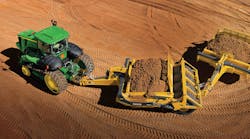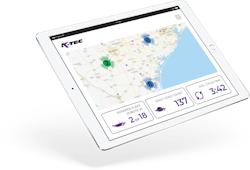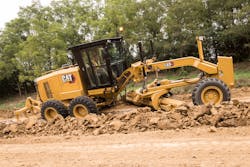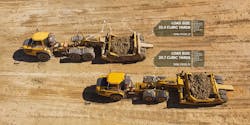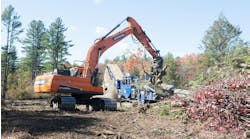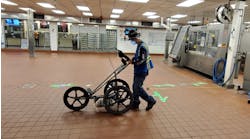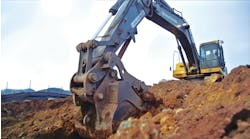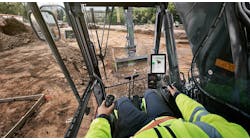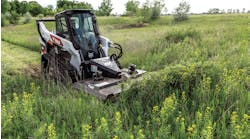Grader Operating Basics
A grader (also referred to as a blade, motor grader, or road grader) pushes soil off to one side as it performs finish grading of the road foundation surface. In doing so, it levels and smooths the earthen surface, creating a flat surface and leaving the required cross grades from the proposed centerline of the road and the profile grades designed for the road’s centerline. Mostly self-propelled, graders typically come equipped with one blade; some graders come with two blades located between the front and rear axles. The front axle is the steering axle directing the grader’s movement. Behind the blade are tandem rear axles fore and aft of an operator’s cab and engine. When a second blade is added it is typically attached in front of the steering axle.
The rear of the grader can be equipped with various attachments such as a ripper to break up rock and hardpan; a scarifier to tear up existing pavement or loosen gravel surfaces and rocks; and a compactor (smooth drum or sheepsfoot) to compact the newly graded surface in one movement. In certain climates and seasons, the main blade can be extended to allow for snow plowing. The overall productivity of the grader typically depends on the characteristics of the blade and the grader’s drive train. The blades themselves vary in width from 8 feet to 24 feet. Depending on the overall size, the engine power varies from 125 hp to 500 hp. Various manufacturers produce multiple types and models of graders, each with their unique capabilities, applications, controls systems, and operating features.
Graders are mostly used in civil construction, roadwork, and underground mining operations (though this is a design for a specialized task). By constructing and maintaining dirt, gravel, and asphalt roads, graders are used to establish fine grades over considerable distances. Finish grading involves preparing a roadway or parking lot for the construction of an asphalt or concrete pavement. A high degree of accuracy is required since everything from surface water run-off to the safety of motorists using the road depends on its final grades. They ensure accuracy; slow and steady wins the race, with the grader typically operating at speeds less than 3 miles per hour, never exceeding second gear while staying in one gear while completing a pass. Pass distances max out at 2,000 feet for linear roadway development and 500 feet for roads and other flat areas associated with site development.
Heavy blading is a construction technique that combines grading with cutting soil, moving, and admixing materials into the final grade surface. Since this involves bulk material movement, full blade loads usually result from this effort. As with other gradings methods, pass lengths are typically less than 2,000 feet. However, operating speeds can go as high as 10 miles per hour while operating in gears 2 through 4.
Site preparation usually involves shorter pass distances since it is performed in preparation for residential, commercial, or industrial development whose layouts included sort road distances. So, pass lengths are typically less than 1,000 feet. Preparations can include finish blading and/or heavy blading.
Maintaining transport roads and haul roads involves the fine grading and recontouring of dirt or gravel road surfaces. This can involve a complete reshaping of the road to correct previous design problems or address the needs of increased traffic loads. The types of soils placed during these operations can vary from soft clays to large rocks, each requiring a different placement technique with an effort that is about half fine and half heavy blading. Unlike other operations, switching gears can be frequent, as different materials can be encountered during the operation, requiring a higher level of operational skill.
Haul roads, with their heavier truck traffic loads, are maintained by graders operating at roughly the same distances, speeds, and gears as transport roads. However, topography can play a major role and impact the grading operations in ways not usually encountered for standard transport roads. Haul roads usually service mining and forestry operations, often located in rough terrain with limited sightlines (and pass distances) and variable slopes. Given these irregularities, blade loads tend to be less than half-sized. Changing topography can limit safe operating speeds.
Graders can also be used on broad, flat areas as well as side banks and slopes as steep as 2 horizontal to 1 vertical. Often the toe or crest of the slope is worked by the grader with the machine running along the outside of the slope while extending its blade to the surface slope. Graders are also capable of cutting ditches and cleaning out accumulated sediments from existing channels. Creating often involves cutting through hard existing soils, while ditch cleaning requires the removal of soft and wet sediments or the reshaping of ditch side slopes. In any case, the operation characteristics of the work can be highly variable.
Operations not requiring direct use of the blade include scarification and ripping. These are done on hardpan soils and even rock strata. The ripper is a hook-like device attached to the rear of the grader that is shoved in the surface to a depth of 6 to 12 inches, hooking into the soil or rock and ripping it as the grader advances. Ripping can also be done to help remove old asphalt and concrete pavement in preparation for new construction. Also attached to the rear is a scarifier whose function is to create deep grooves or ruts in the hard surface. Operating speeds depend on local topography and soil conditions with gear ranges and pass distances depending on the overall type of project.
Simplified Scrapers
Simply put, while graders move soil, scrapers re-move it. Whether self-propelled, attached to tractors, or dragged behind other heavy equipment, scrapers can be applied to many different applications. Towed scrapers tend to be less expensive while self-propelled scrapers are more versatile and productive. In highway and other construction applications, scrapers are used for moving soil over long distances (up to 2 miles). It consists of a wheeled, open-topped wagon with an open front gate having a bladed bottom edge. As it moves or is pulled forward, it forces the blade through the soil at the preset operational depth (which depends on the distance of the pass, type of soils, etc.) which in turn forces the soil up and over the blade into the empty wagon. After the wagon is filled, the gate is closed and its load of cut soil is taken to a designated spot for dumping or stockpiling. Given its capacity, productivity, and ability to work effectively over long linear distances, the scraper is a primary road building tool.
Drawn scrapers can be configured to provide sole compaction as well as excavation through the use of multiple tires and heavyweight loads. This allows the scraper to serve a duo function, compacting the excavated soil at the stockpile or disposal area. As it can cut consisted thicknesses of soil it can also place soil in consistent lift thickness in preparation for subsequent compaction. In this way, scrapers are used for both cut and fill operations. The overall operating cost savings can be substantial.
Pull-pan ejector scrapers provide three important functions of self-loading material in the cut zone, transporting the material on the haul road, and finely spreading the material out in the fill area—all in one machine. These requirements make pull pan ejector scrapers the right choice for bulk earthwork operations associated with roadway building, clearing and grubbing, and site development. Other equipment, such as bulldozers and graders, can scrape away soil and grade surfaces, but only scrapers can also remove and transport bulk quantities of soil in one movement.
Given their size and power, scrapers are considered useful for work in heavier and harder soils. Other equipment may require dry soil conditions for high productivity, but scrapers can work in wet soil and even muck. This eliminates the need for more specialized equipment, up to three separate machines, reducing a fleet operator's ownership costs. The result is an overall 30% reduction in fuel consumption and associated maintenance and operating costs. Optimum operating conditions include haul distances under 2,500 feet, soil densities of less than 3,000 pounds per cubic yard, and no large objects (broken concrete, boulders, tree stumps, etc.). They can also operate over soft grounds allowing it to work in soft foundation conditions.
Efficiency, Productivity, and Control
Efficiency is the key to making money as an earthwork contractor. Time is money, and the more earth that can be moved in a given period translates into higher profits. Greater individual efficiency translates into needing fewer such pieces of equipment on a given job site. Less equipment means fewer headaches and queuing delays by the equipment fleet—an important, if indirect, source of further cost savings.
Scraper productivity is a function of many factors, both local conditions and equipment operating characteristics. Equipment characteristics include gross operating weight (weight of the machine plus the weight of its soil load), soil storage capacity, gate width, engine horsepower, gear used during the operation, operating speed, etc. Operating characteristics include effective grade (also referred to as total resistance) and Rimpull. Effective grade is the sum of both the slope grade and the rolling resistance. Rimpull is the force measured in pounds between the tire and the ground resulting from traction and surface friction. The distance traveled from the area of excavation to the point of disposal combined with the operating speed, and the time to fully load the grader (loading and maneuvering time), gives the machine's total cycle time. Taking its full capacity and dividing it by the total cycle times (modified by an efficiency factor affected by operator experience, weather conditions, visibility, etc.) gives the machine's total productivity per hour or workday.
Grader productivity is simpler to calculate. It is a function of the hourly operating area, the operating speed, effective blade length, overlap with areas of other passes, and the same job efficiency factors cited above for scrapers.
Operating cabs can be equipped with additional advanced control systems. These can include exterior cameras, especially rearward cameras to assist in safe backing up, LED light on the dashboard for low light operating conditions (dusk, dusk, even working under the lights at night), service lights that aid in engine and drive train maintenance, and GPS guidance systems to ensure near perfection in alignment, grade, and elevation of the finished soil surface.
Major Suppliers
Caterpillar, Inc.
Cat motor graders offer a choice of controls, steering wheel, and lever or joystick to fit customer and operator need or preference as well as the choice of drive with rear tandem drive machine or all-wheel-drive depending on site requirements and traction needs. Cat Motor graders have more integrated technology available which will allow the machine equipped with technology to increase its ability to complete more applications/tasks on the site with more working range of the moldboard.
Another technology is Auto Articulation, which when engaged allows the rear tires to follow the front through machine articulation activation, but the operator only has to provide steering input. Auto articulation increases machine and operator efficiency with quicker machine turn arounds at the end of the pass and allows operators to get back into moving material on the next pass. Cat Grade technologies offer integrated 2D auto cross slope for use to maintain a needed slope. The operator sets the needed slope and engages automatically on one side of the moldboard and then controls the other side of the moldboard, and the automatic side of the moldboard follows the manually controlled side of the moldboard to keep a constant, desired grade.
The Cat Grade Cross Slope system can also provide a real-time readout of the slope of the moldboard and machine mainfall providing the rolling survey for the operator. Cat Motor graders also have Cat Grade 3D available which is an integrated mastless 3D GNSS system which gives the operator the advantages of 3D GNSS accuracy without the masts inhibiting the working range of the moldboard. Cat Grade 3D provides full use of wheel lean, blade pitch center shift, and articulation increasing utilization of the grader when using technology. Cat Grade 3D also provides an auto side shift to allow one tip of the moldboard to follow a desired line on the design plan. Cat Grade 3D includes E-fence, which a virtual fence to prevent the top of the drawbar from contacting the link bar and prevents the moldboard from contacting the tires or ladder on the machine, providing increased efficiency with less downtime. Standard offerings on Cat Motor graders include standard secondary steering on all joystick-equipped machines.
The new Cat 140 GC motor grader is designed to combine high performance with low owning and operating costs. The 140 GC's powerful Cat C7.1 engine, 6F/3R automatic power-shift transmission (which eliminates the inching pedal), and precisely designed hydraulic system ensure balanced performance in all operating situations. An ECO operating mode and demand-fan reduce fuel consumption, and extended maintenance intervals further reduce operating costs. Operators of all skill levels quickly achieve high production with the 140 GC and options that include adjustable seats and efficient heating/cooling systems to guarantee comfort.
John Deere
According to Grant Van Tine, Solutions Marketing Manager at John Deere: John Deere SmartGrade, the industry’s first mastless grade control system for motor graders, integrates all components into the machine, eliminating additional masts and cables from the moldboard that are vulnerable to damage or theft. For this reason, SmartGrade motor graders are an excellent choice to use during site clearing, all the way through final grade. SmartGrade allows operators to get to grade faster in fewer passes, without the risk of over- or undercutting, optimizing efficiency throughout each phase of the project.
John Deere motor graders have the highest horsepower in their size class to give operators the most performance out of their machines when they need it. Additionally, John Deere has continuously developed new innovative features, from cross-slope to SmartGrade mastless grade control to advanced automation features that ultimately help contractors manage costs, performance, and efficiency. To help contractors facing labor challenges and eroding margins, John Deere is committed to developing new features that improve the ease of operation, performance, and efficiency of motor graders.
Automation features on John Deere graders improve efficiency, accuracy, and simplify machine operation, which benefits both new and experienced operators. What started with features like cross-slope and return-to-straight have evolved into SmartGrade mastless grade control and other advanced automation features. All John Deere GP (GradePro) motor graders come standard with automated cross-slope, which simplifies holding a consistent slope by reducing operation to a single lever. Optional SmartGrade allows operators to get to grade faster in fewer passes, without the risk of over- or undercutting. Optional on GP models and standard with SmartGrade are three additional features: Auto-Articulation, Blade Flip, and Machine Presets. Auto-Articulation combines front steering and rear articulation while blade flip, a Deere exclusive, allows the operator to automatically rotate the blade to a set position without holding the control at the end of a pass. Machine Presets, another Deere exclusive, allows the operator to activate multiple pre-set functions by pressing a single button. This type of automation reduces the number of controls and buttons operators need to use to complete common tasks. These features simplify operation, reduce fatigue, and improve accuracy.
Looking at scraper systems, the Earthmoving Productivity System that was unveiled at CONEXPO in March of 2020 is the latest technology feature developed by Deere and designed to improve operator efficiency. The Earthmoving Productivity System will determine the amount of volume being loaded into a scraper in real-time and will transfer that critical data back to the operator in the cab via the display and to the site managers via JDLink. This system features several components proven and tested in the market, in addition to newer technologies that are enabling more accurate data collection and distribution. The system was very well received and generated a lot of exciting discussions when it was introduced. Customers were surprised to learn what level of information the Earthmoving Productivity System can generate, particularly regarding the level of accuracy of the data. This enables customers to make more data-driven decisions related to their particular job site and working conditions.
K-Tec Earthmovers
K-Tec offers contractors the largest construction pull-pan scrapers in the market with durable scrapers ranging from 28 to 63 cubic yards. Fleets of K-Tec's high-capacity scrapers are prevalent in the heavy construction market and are frequently spotted on site clearing and road-building projects around the world. The construction-grade K-Tec scraper performs in almost any condition from rock quarries to the muddiest, softest soil conditions in North America, to the sands of Australia and Saudi Arabia.
Using K-Tec scrapers, primary scraper functions can be provided by a single operator, with a single-engine to keep idle time, labor, and fuel costs at a minimum. K-Tec revolutionized the scraper market by releasing the first-ever ADT Scraper concept. K-Tec was the pioneer to develop the technology of hooking up an articulated dump truck to pull a scraper. It is a massive advantage for a contractor to be able to use an existing fleet of ADTs and convert them into efficient, self-loading scraper haulers. Not only can the trucks be utilized for a new purpose, but also that same truck driver can now easily transition into an effective scraper operator, behind the same familiar wheel to add efficiency and productivity to the project.
However, since its inception in 2000, the K-Tec scraper has been designed as a technologically advanced machine. K-Tec has spent years of research and development in refining the optimal earthmoving scraper and leading the industry in revolutionary product technologies. In pioneering pull-pan scraper telematics, K-Tec is continuing the trend of making scrapers “smarter” and more intuitive for earthmoving operations.
K-Tec Scraper Telematics provides benefits across the various levels of an earthmoving operation. It starts with scraper operators receiving real-time feedback on optimizing load count productivity and payload capacities on their in-cab display screen. Service technicians will also benefit from K-Tec Scraper Telematics, as they can easily receive mobile message notifications when maintenance tasks are due, or if system fault codes are reported for troubleshooting. The reminder alerts will pop-up to have them confirm completion on the scheduled intervals that the operator/service mechanic is supposed to perform a task. Examples range from greasing, to tire pressure, and cutting-edge checks, ensuring maximum performance of the machine. Site supervisors may view job site cycle time and load time performance, with average hauling speed and distances on a tablet in the comfort of their pickup truck as a benefit to ensure a smooth and productive operation. Finally, business owners can benefit by calculating their cost of moving material from their office, while protecting their investment with anti-theft GPS tracking on scrapers across various job sites using K-Tec Scraper Telematics.
